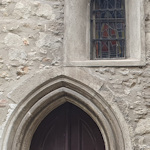
When the first mason probably started work on the Ruprechtskirche (St. Rupert’s church), the Kingdom of England still wouldn’t exist for another 100 years.
The oldest church in Vienna makes most of its neighbours look like toddlers.
- Possibly well over 1000 years old
- Romanesque design and still a parish church today
- Noted location in The Third Man
- Book a classical concert* in a church or palais
- See also:
St. Rupert’s church
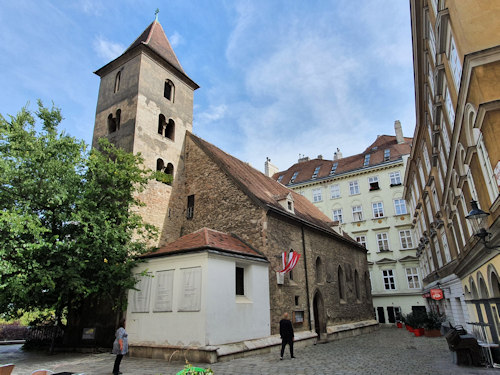
(Small but significant)
A little patch of the town centre in Vienna goes by the name of the Bermuda Triangle. Bars and restaurants pepper old streets free of traffic, and the area echoes at night to the sound of tinkling wine glasses and good company.
Perhaps surprisingly, that very same area also houses two venerable religious institutions.
One is the 1826 city temple of Vienna’s Jewish community: a lone survivor from the days of Nazi oppression.
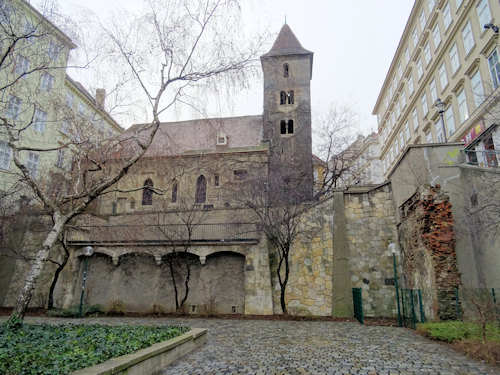
(The church and some of the old city fortifications)
The other is the Romanesque Ruprechtskirche, a church whose roots date back perhaps over a thousand years.
Ruprechtskirche sits on a slight elevation above one of the few remaining pieces of the old city fortifications that once kept the Ottoman empire at bay. The church seems to defy its surrounds, squatting slightly incongruously among houses from the early 1830s.
One side looks across to a small arm of the Danube (the so-called Donaukanal), though this was not always the case: WWII bombs apparently destroyed the house that used to block the view of the water.

(The church photographed from the south by Josef Mutterer around 1890; you can see the housing beyond that no longer exists; Wien Museum Inv.-Nr. 28143; excerpt reproduced with permission under the terms of the CC0 licence)
Watch the movie The Third Man, and you’ll see the main protagonists (Holly Martins and Anna Schmidt) run past the church and down the steps toward the river just a few years after the war ended.
The true age of the building remains unclear. We can certainly consider it the oldest standing church in the city, and it still serves an active parish.
(Incidentally, you’re not far from another remarkably old church: the Gothic Maria am Gestade on Salvatorgasse and a location that, coincidentally, also featured in The Third Man.)
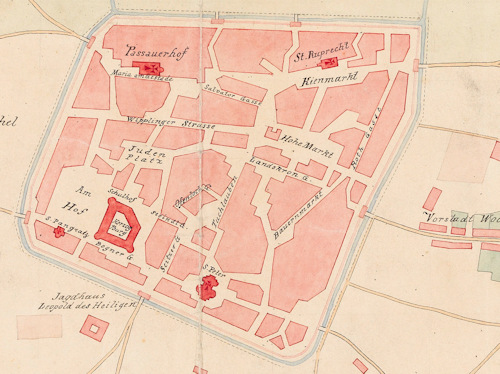
(Excerpt from a reconstructed map of the Imperial city of Vienna in 1147; edited by Carl Graf Vasquez and produced in 1861. St. Ruprecht’s is marked in the top right; Wien Museum Inv.-Nr. 8404; reproduced with permission under the terms of the CC0 licence)
Some evidence suggests Ruprechtskirche may have first appeared around the turn of the 8th and 9th centuries (!), immediately after the successful conquest of the Pannonian Avars (tribal nomads) by the Christian Franks.
The first documented official mention dates back to 1200, which already describes the church as the oldest in the settlement.
Needless to say, the building now combines bits and pieces from throughout the centuries: bells from the 13th century, for example.
Curiously, the institution has a strong connection to the salt (German: Salz) trade; nearby street names like Salzgries or Salztorgasse hark back to those times.
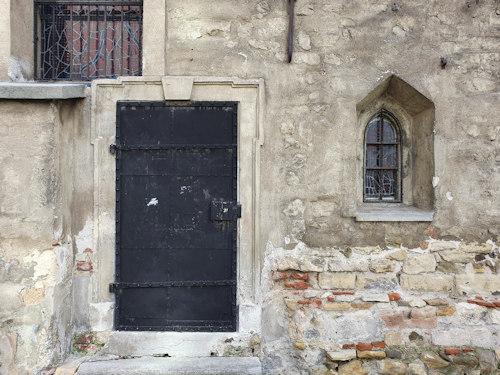
(A doorway to history)
St Rupert is the patron saint of Salzburg and salt from west Austria would have been unloaded from the river transports in this part of Vienna.
The Salzamt royal salt monopoly building and Ruprechtskirche were even neighbours, with the former (and the associated trade) long-time custodians and benefactors of the church.
How to get to the Ruprechtskirche
Like most locations in the centre, Ruprechtskirche is just a short walk from public transport options.
Should you be traipsing along the usual sightseeing routes around Stephansdom cathedral, simply wander northish down Rotenturmstraße to reach the area.
Subway: The Schwedenplatz transport hub, for example, is just a bit further up along the Donaukanal (U1 and U4 subway lines)
Tram: Lines 1 and 2 stop at Schwedenplatz. The 1 also stops at Salztorbrücke, also close by in the other direction along the Donaukanal.
Bus: The old town bus lines stop nearby. For example, take the 3A to Salzgries, the 2A to Schwedenplatz or Rotenturmstraße, or the 1A to Hoher Markt.
Address: Ruprechtsplatz 1, 1010 Vienna | Website